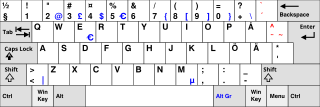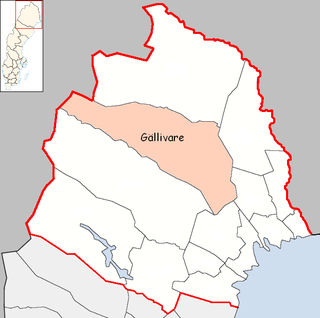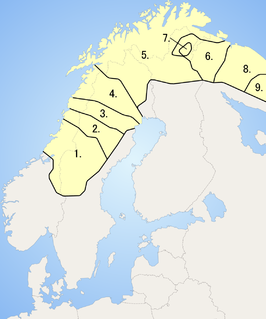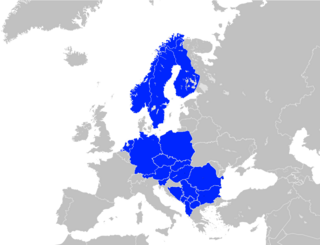 W
WSwedish is the official language of Sweden and is spoken by the vast majority of the 10.23 million inhabitants of the country. It is a North Germanic language and quite similar to its sister Scandinavian languages, Danish and Norwegian, with which it maintains partial mutual intelligibility and forms a dialect continuum. A number of regional Swedish dialects are spoken across the county. In total, more than 200 languages are estimated to be spoken across the county, including regional languages, indigenous Sámi languages, and immigrant languages.
 W
WDanish is a North Germanic language spoken by about six million people, principally in Denmark, Greenland, the Faroe Islands and in the region of Southern Schleswig in northern Germany, where it has minority language status. Also, minor Danish-speaking communities are found in Norway, Sweden, Spain, the United States, Canada, Brazil, and Argentina. Due to immigration and language shift in urban areas, about 15–20% of the population of Greenland speak Danish as their first language.
 W
WElfdalian or Övdalian is a North Germanic language variety spoken by up to 3,000 people who live or have grown up in the locality of Älvdalen, which is located in the southeastern part of Älvdalen Municipality in northern Dalarna, Sweden.
 W
WFinnish is a Uralic language of the Finnic branch spoken by the majority of the population in Finland and by ethnic Finns outside Finland. Finnish is one of the two official languages of Finland. In Sweden, both Finnish and Meänkieli are official minority languages. The Kven language, which like Meänkieli is mutually intelligible with Finnish, is spoken in the Norwegian county Troms og Finnmark by a minority group of Finnish descent.
 W
WGällivare dialects are a dialect group of Meänkieli or Northern Finnish. They are spoken around Gällivare, but also in Killivaara and Nattavaara. Features of the dialects are absence of Vowel harmony: kyla 'village', and the passive being used for the third person plural ending: äijät poltethin. The dialect is also heavily influenced by Swedish and many loanwords have entered the Gällivare dialects. A Gällivare dialect dictionary was made in 1992 by Birger Winsa.
 W
WJämtland dialects constitute a group of closely related dialects spoken in the Swedish province of Jämtland. They are commonly used in the entire region, with the exception of Frostviken in the northernmost part of the province, where the local dialect is of Trøndersk origin, due to its later settlement from Norway. In the eastern part of Jämtland the dialects are transitional to those of Ångermanland. The dialect group is commonly regarded and treated as a single entity. Some people consider it a language separate from Swedish.
 W
WLule Sami is a Uralic, Sámi language spoken around the Lule River, Sweden, and in the northern parts of Nordland county in Norway, especially Tysfjord municipality, where Lule Sámi is an official language. It is written in the Latin script, having an official alphabet.
 W
WMeänkieli is a Finnic language or a group of distinct Finnish dialects spoken in the northernmost part of Sweden along the valley of the Torne River. Its status as an independent language is disputed, but in Sweden it is recognized as one of the country's five minority languages.
 W
WNorthern or North Sami is the most widely spoken of all Sami languages. The area where Northern Sami is spoken covers the northern parts of Norway, Sweden and Finland. The number of Northern Sami speakers is estimated to be somewhere between 15,000 and 25,000. About 2,000 of these live in Finland and between 5,000 and 6,000 in Sweden.
 W
WThe orthography used to write Northern Sámi has experienced numerous changes since the first writing systems for the language were developed. Traditionally, Norway, Sweden, and Finland — the three countries where Northern Sámi is spoken — used separate orthographies for teaching the Sámi within their borders. This changed in 1979 when a Saami Council-led effort to standardize a pan-Scandinavian orthography for Northern Sámi.
 W
WPite Sami or Arjeplog Sámi is a Sámi language traditionally spoken in Sweden and Norway. It is a critically endangered language that has only about 25–50 native speakers left and is now only spoken on the Swedish side of the border along the Pite River in the north of Arjeplog and Arvidsjaur and in the mountainous areas of the Arjeplog municipality.
 W
WRomani is an Indo-Aryan macrolanguage of the Romani communities. According to Ethnologue, seven varieties of Romani are divergent enough to be considered languages of their own. The largest of these are Vlax Romani, Balkan Romani (600,000), and Sinte Romani (300,000). Some Romani communities speak mixed languages based on the surrounding language with retained Romani-derived vocabulary – these are known by linguists as Para-Romani varieties, rather than dialects of the Romani language itself.
 W
WSámi languages, in English also rendered as Sami and Saami, are a group of Uralic languages spoken by the Sámi people in Northern Europe. There are, depending on the nature and terms of division, ten or more Sami languages. Several spellings have been used for the Sámi languages, including Sámi, Sami, Saami, Saame, Sámic, Samic and Saamic, as well as the exonyms Lappish and Lappic. The last two, along with the term Lapp, are now often considered pejorative.
 W
WSouthern or South Sámi is the southwesternmost of the Sámi languages, and is spoken in Norway and Sweden. It is an endangered language; the strongholds of this language are the municipalities of Snåsa, Røyrvik, Røros and Hattfjelldal in Norway.
 W
WSwedish is a North Germanic language spoken natively by at least 10 million people, predominantly in Sweden and in parts of Finland, where it has equal legal standing with Finnish. It is largely mutually intelligible with Norwegian and Danish, although the degree of mutual intelligibility is largely dependent on the dialect and accent of the speaker. Written Norwegian and Danish are usually more easily understood by Swedish speakers than the spoken languages, due to the differences in tone, accent, and intonation. Swedish is a descendant of Old Norse, the common language of the Germanic peoples living in Scandinavia during the Viking Era. It has more speakers than any other North Germanic language.
 W
WSwedish Sign Language is the sign language used in Sweden. It is recognized by the Swedish government as the country's official sign language, and hearing parents of deaf individuals are entitled to access state-sponsored classes that facilitate their learning of SSL. There are fewer than 10,000 speakers, making the language officially endangered.
 W
WUme Sámi is a Sámi language spoken in Sweden and formerly in Norway. It is a moribund language with only about 10-20 native speakers left. It was spoken mainly along the Ume River in the south of present-day Arjeplog, in Sorsele and in Arvidsjaur.